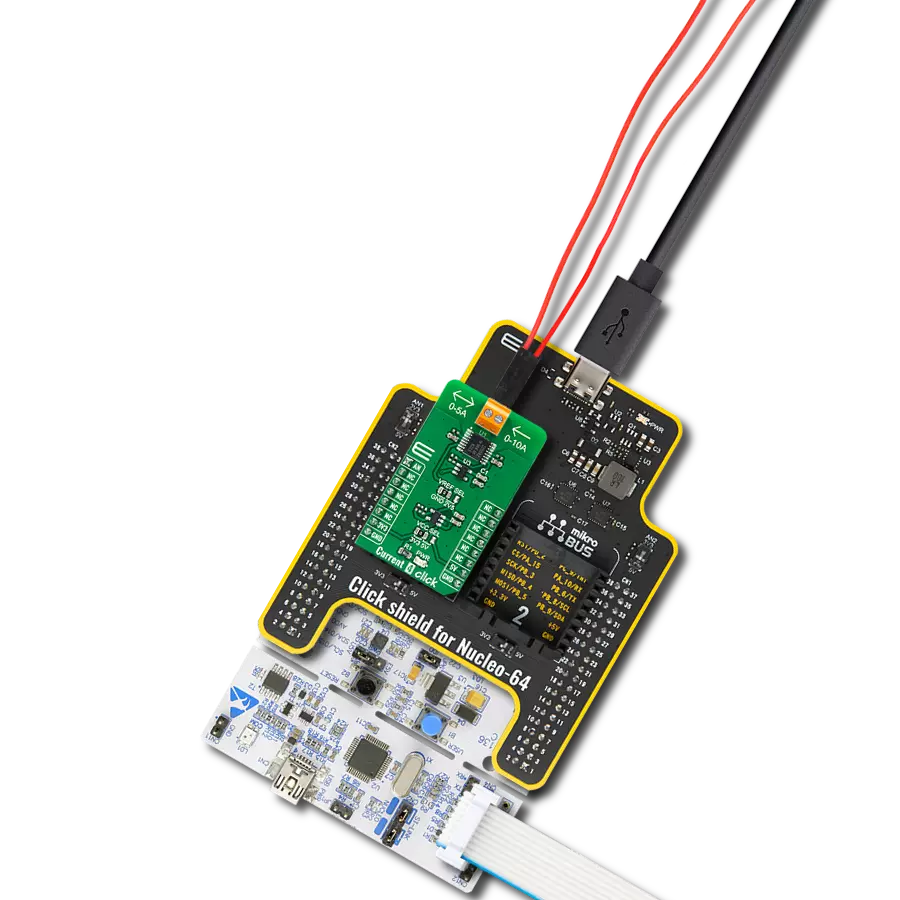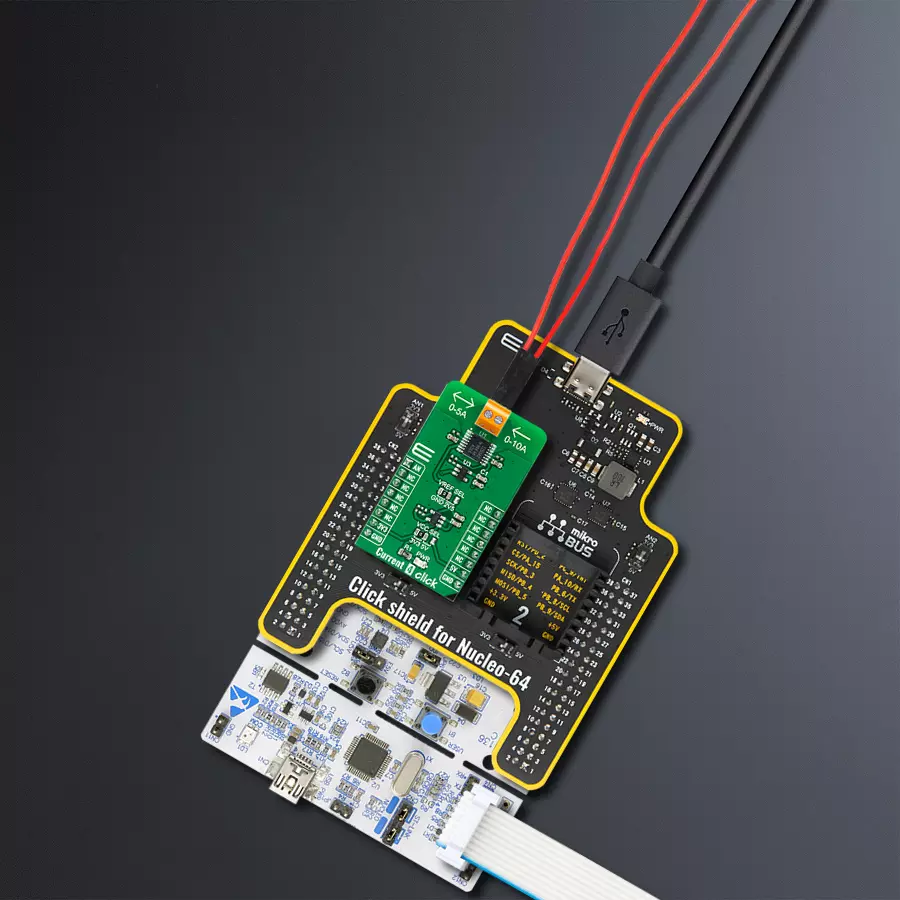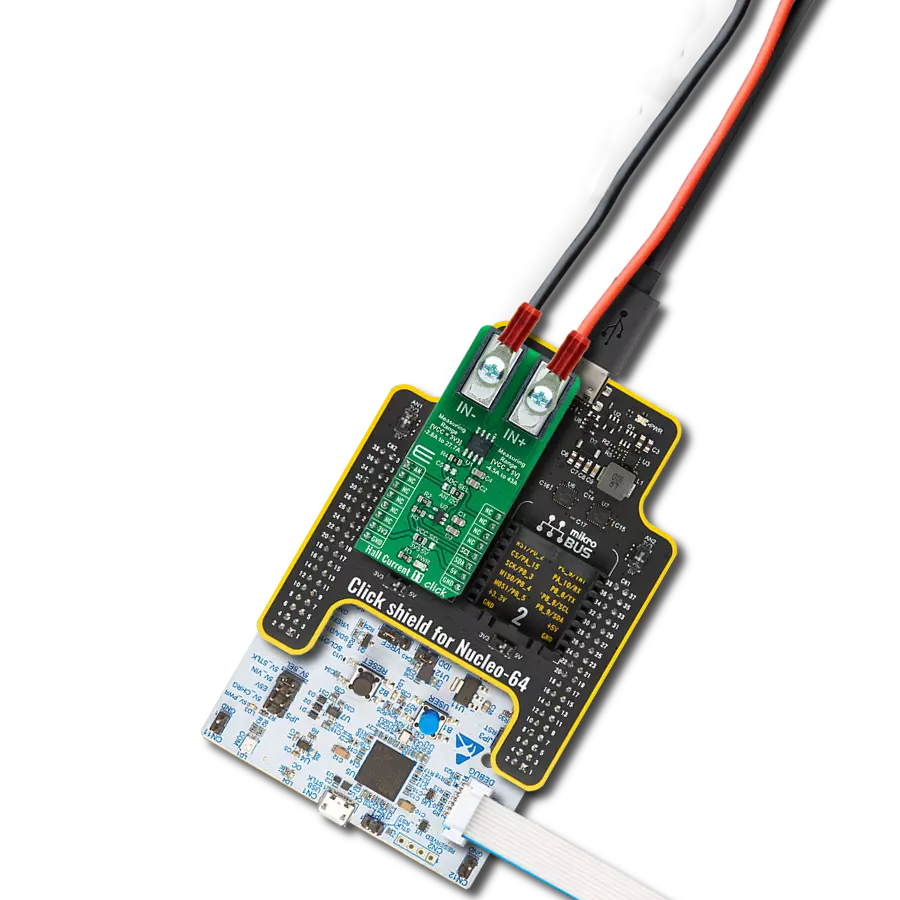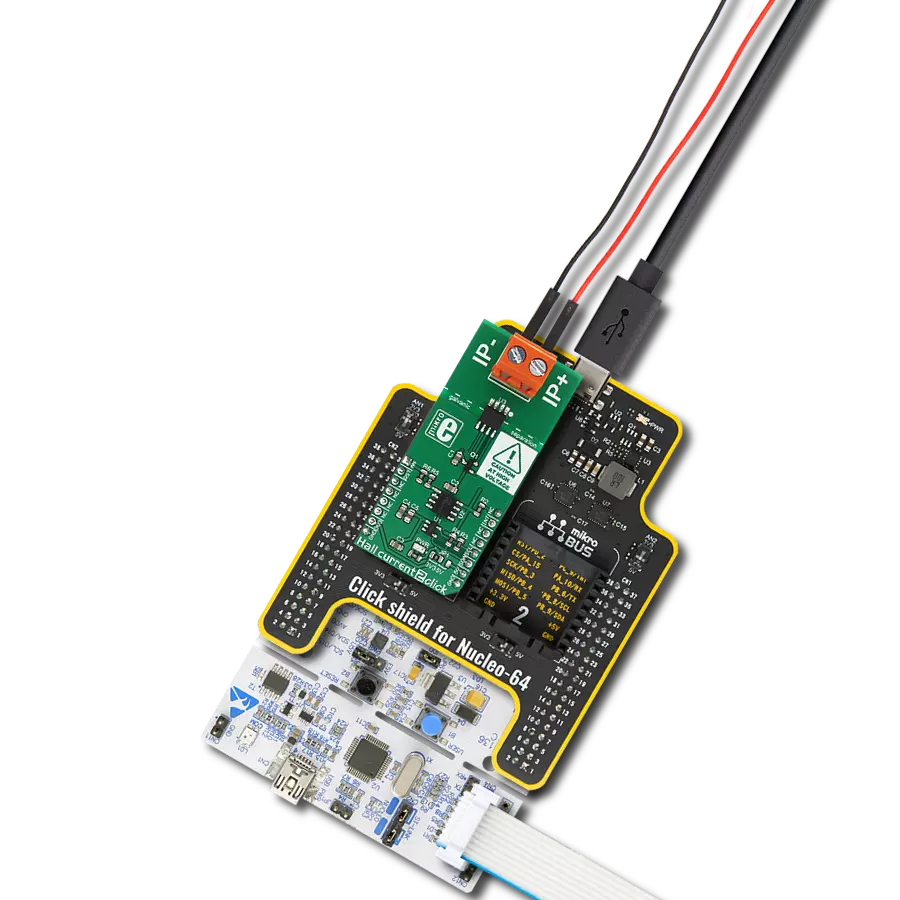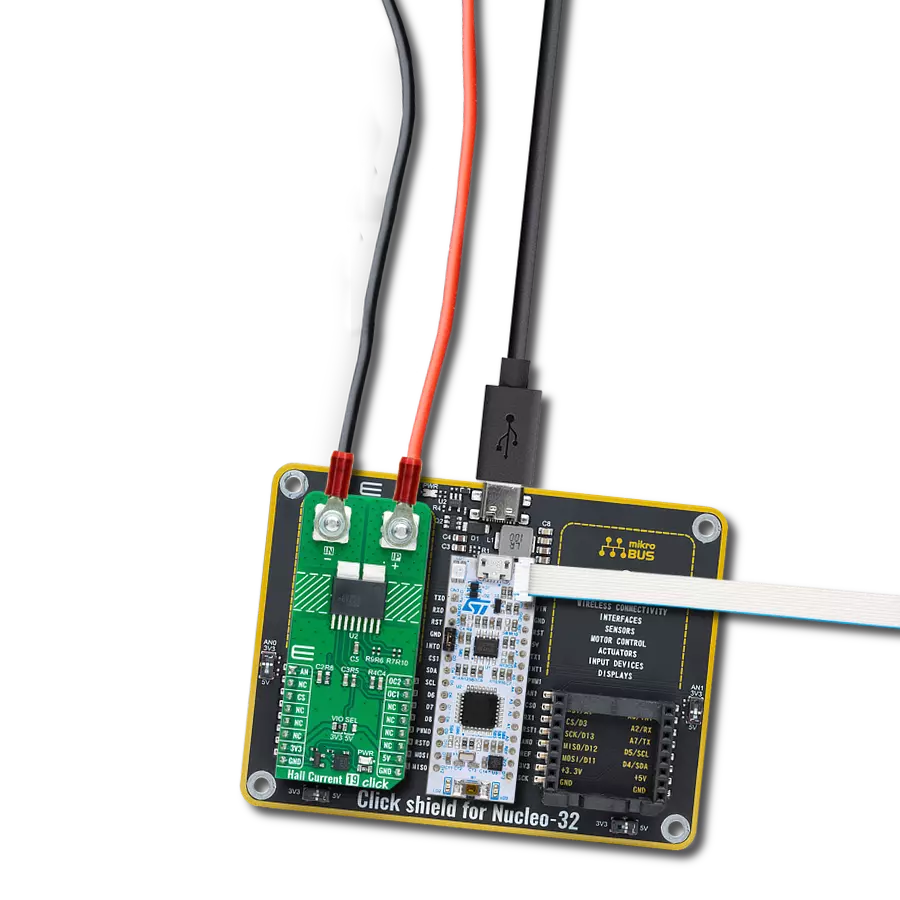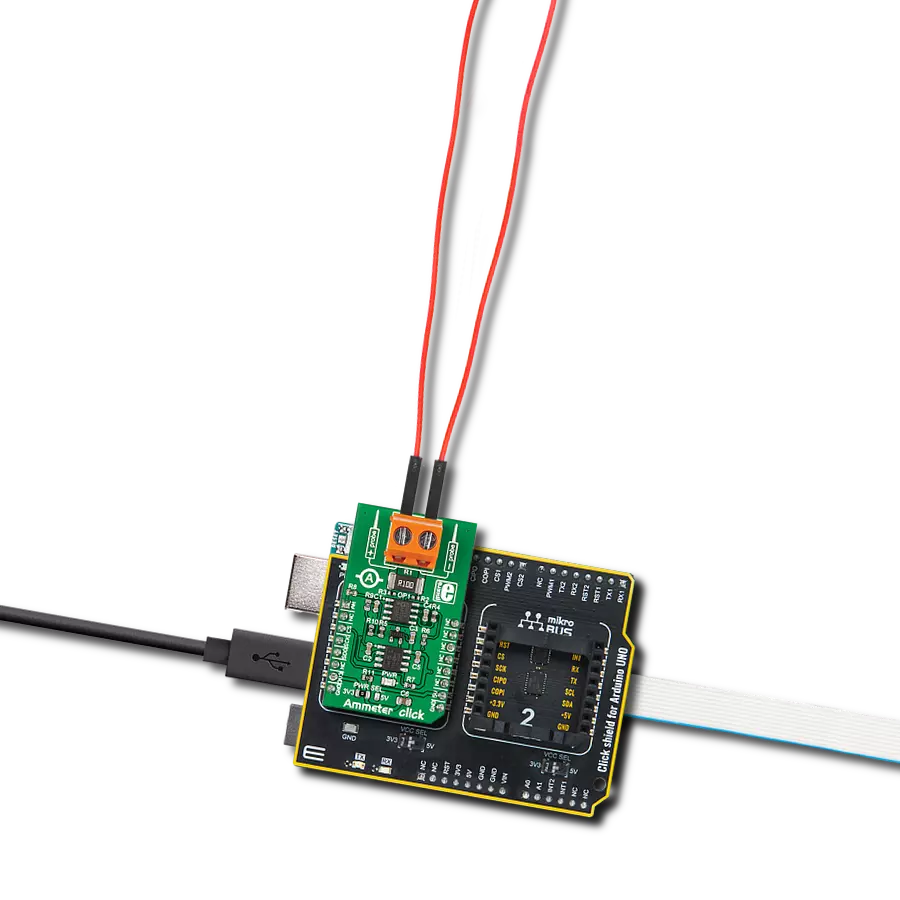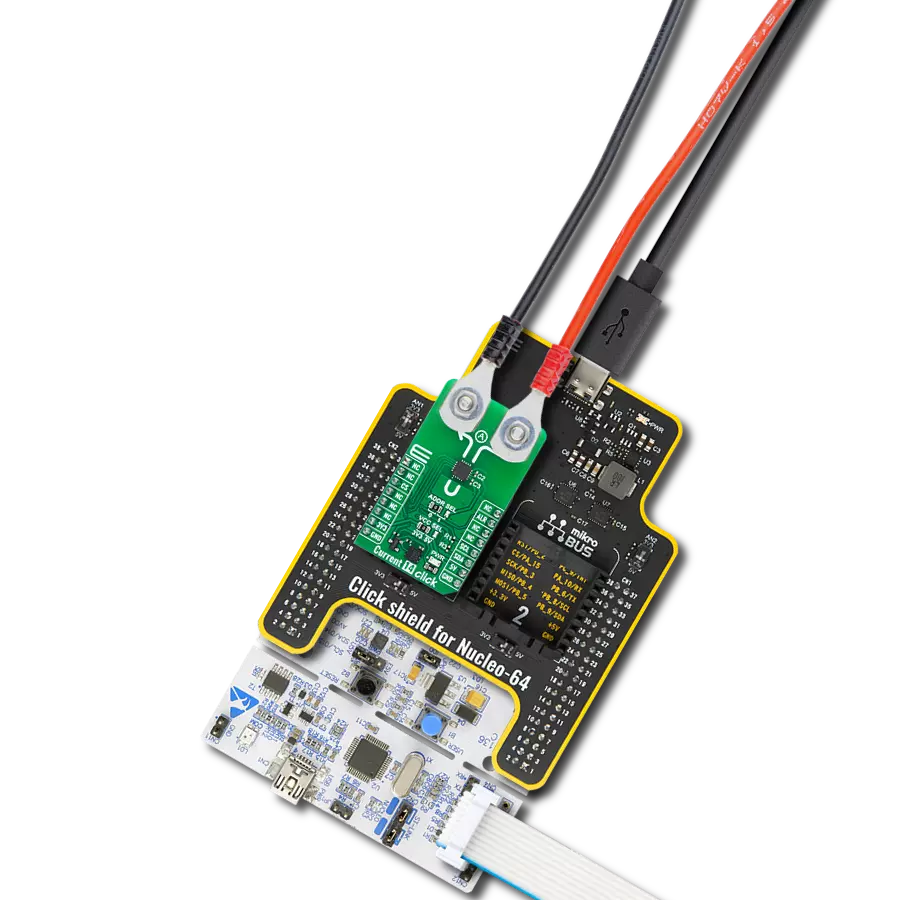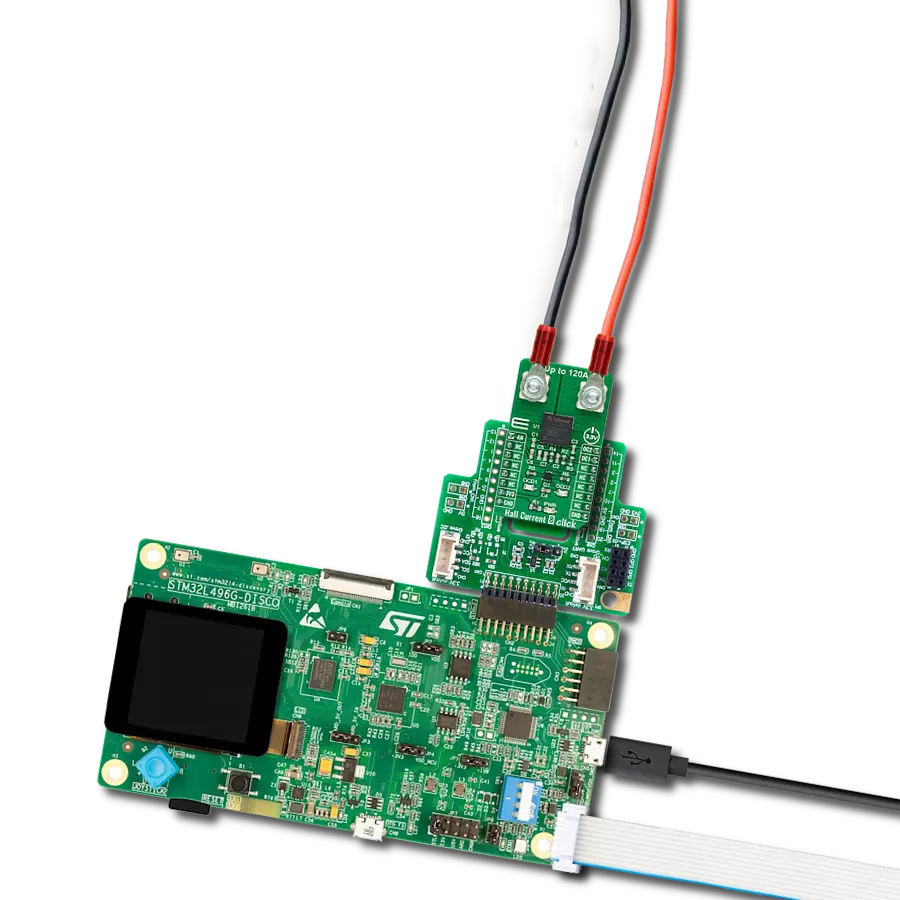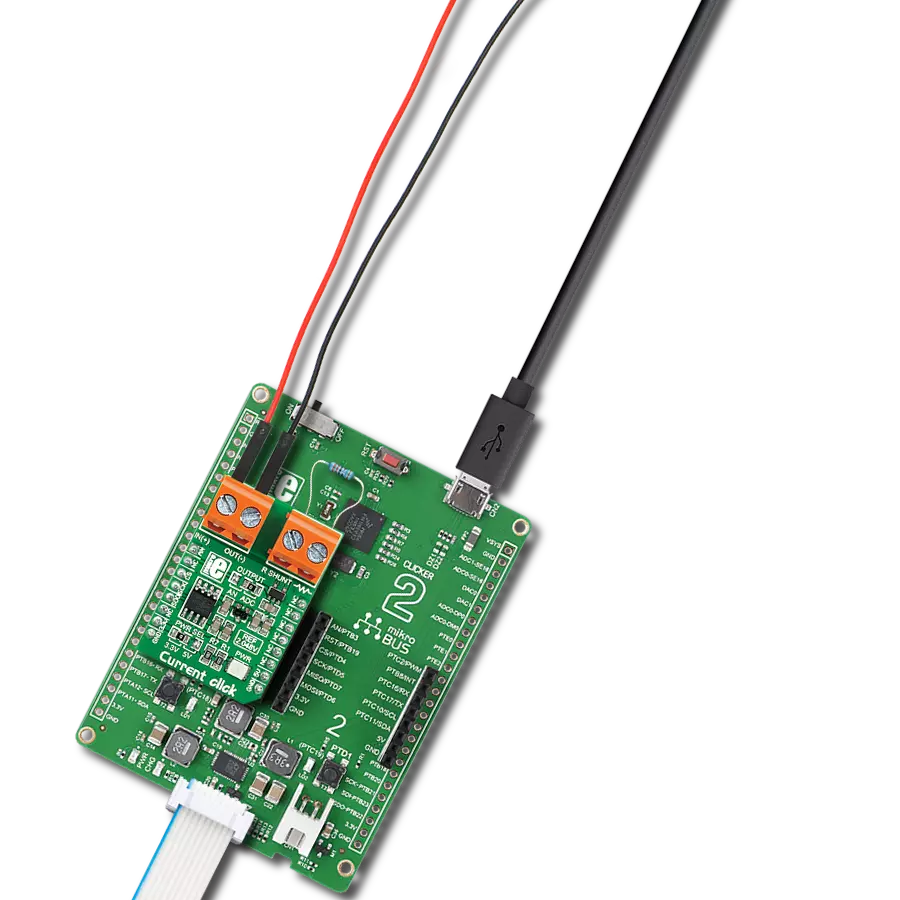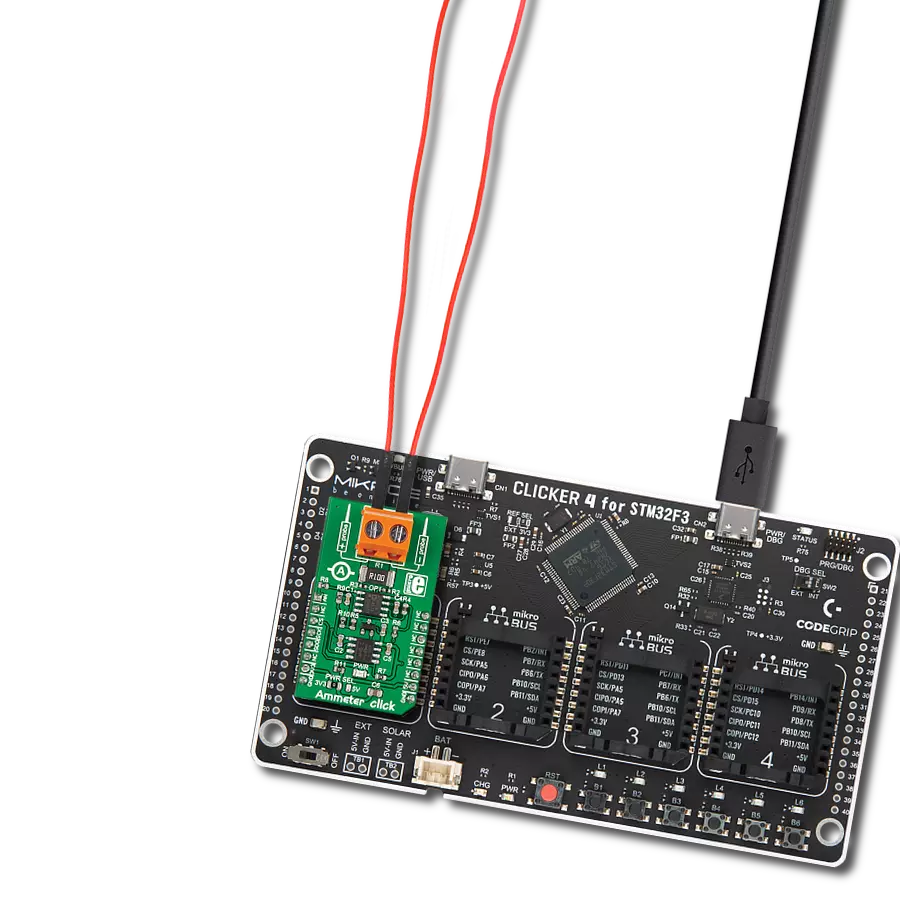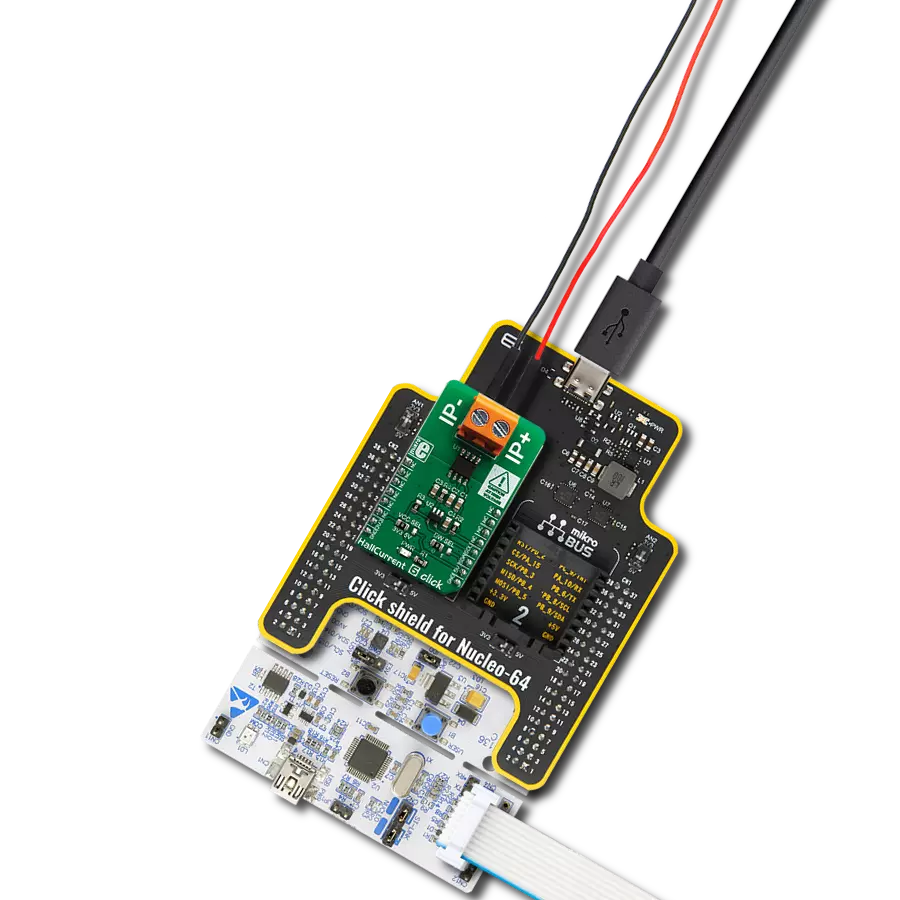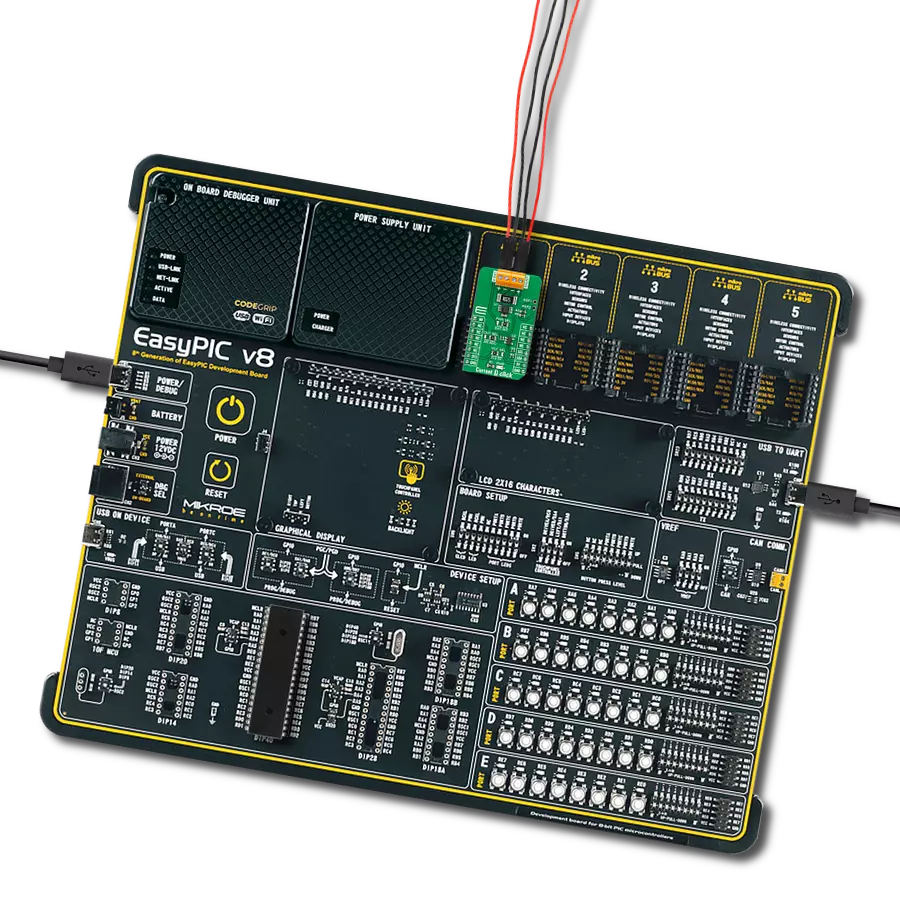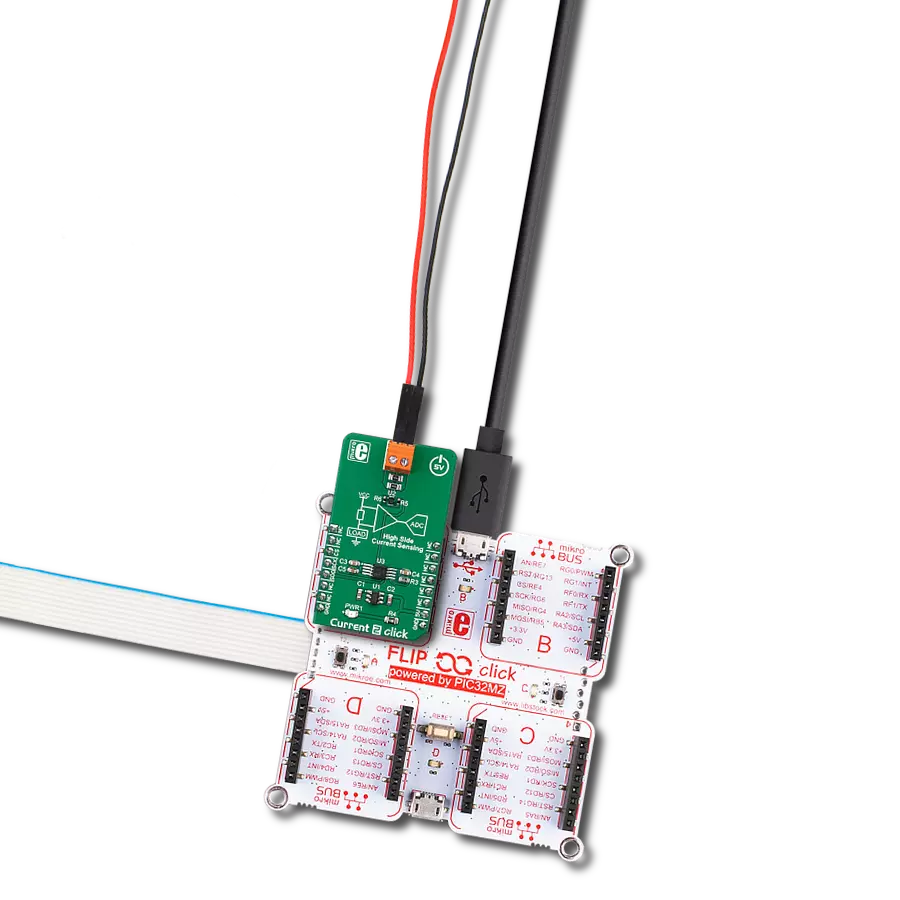Achieve operational excellence by utilizing our current measurement solution to track current variations, enabling you to make data-driven decisions for improved efficiency and reduced downtime
A
A
Hardware Overview
How does it work?
Current 4 Click is based on the INA250, a current-sense amplifier with a high-precision, low-drift shunt resistor, which can deliver highly accurate measurements over a wide temperature range from Texas Instruments. The INA250 measures the voltage developed across the internal current-sensing resistor when current passes through it. The integrated 2mΩ shunt resistor offers 0.1% tolerance and a low drift of 15pmm/°C, enabling the higher performance of the end equipment. This amplifier allows for high-accuracy current measurements at common-mode voltages and offers a maximum error of 0.84% over a wide temperature range. Current 4 Click communicates with MCU using only one pin routed on the AN pin of the mikroBUS™ socket. The output analog
signal from INA250 is forwarded to the input of the operational amplifier, the LMV321 low-voltage rail-to-rail OpAmp from Texas Instruments, representing the most cost-effective solution for applications where low voltage operation is needed. The output of the LMV321 OpAmp has a stable unity gain, acting as a buffer so that the host MCU can sample the output voltage of the INA250 via the AN pin of the mikroBUS™ socket. The INA250 can be configured to measure both unidirectional and bidirectional currents through the reference voltage level. For unidirectional operation, the reference pin should be tied to the ground. When the current increases, the output signal increases upwards from this reference voltage (or ground in this case). For bidirectional
currents, an external voltage source can be used as the reference voltage; in this case, a low dropout linear regulator AP7331 from Diodes Incorporated provides the 2.5V reference supply voltage for the INA250. The reference voltage level can be selected by positioning the SMD jumper labeled VREF SEL to an appropriate position choosing between 2.5V provided by AP7331 or GND. This Click board™ can operate with either 3.3V or 5V logic voltage levels selected via the VCC SEL jumper. This way, both 3.3V and 5V capable MCUs can use the communication lines properly. Also, this Click board™ comes equipped with a library containing easy-to-use functions and an example code that can be used, as a reference, for further development.

Features overview
Development board
Nucleo-64 with STM32F091RC MCU offers a cost-effective and adaptable platform for developers to explore new ideas and prototype their designs. This board harnesses the versatility of the STM32 microcontroller, enabling users to select the optimal balance of performance and power consumption for their projects. It accommodates the STM32 microcontroller in the LQFP64 package and includes essential components such as a user LED, which doubles as an ARDUINO® signal, alongside user and reset push-buttons, and a 32.768kHz crystal oscillator for precise timing operations. Designed with expansion and flexibility in mind, the Nucleo-64 board features an ARDUINO® Uno V3 expansion connector and ST morpho extension pin
headers, granting complete access to the STM32's I/Os for comprehensive project integration. Power supply options are adaptable, supporting ST-LINK USB VBUS or external power sources, ensuring adaptability in various development environments. The board also has an on-board ST-LINK debugger/programmer with USB re-enumeration capability, simplifying the programming and debugging process. Moreover, the board is designed to simplify advanced development with its external SMPS for efficient Vcore logic supply, support for USB Device full speed or USB SNK/UFP full speed, and built-in cryptographic features, enhancing both the power efficiency and security of projects. Additional connectivity is
provided through dedicated connectors for external SMPS experimentation, a USB connector for the ST-LINK, and a MIPI® debug connector, expanding the possibilities for hardware interfacing and experimentation. Developers will find extensive support through comprehensive free software libraries and examples, courtesy of the STM32Cube MCU Package. This, combined with compatibility with a wide array of Integrated Development Environments (IDEs), including IAR Embedded Workbench®, MDK-ARM, and STM32CubeIDE, ensures a smooth and efficient development experience, allowing users to fully leverage the capabilities of the Nucleo-64 board in their projects.
Microcontroller Overview
MCU Card / MCU
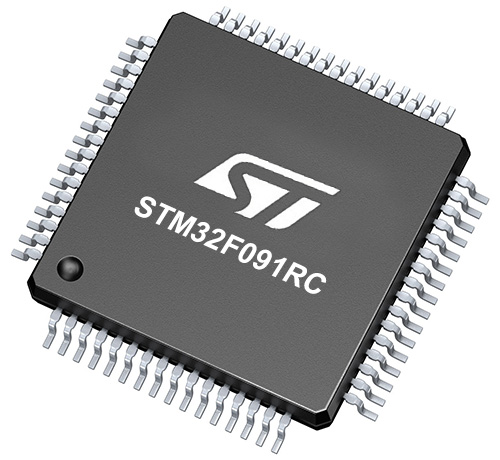
Architecture
ARM Cortex-M0
MCU Memory (KB)
256
Silicon Vendor
STMicroelectronics
Pin count
64
RAM (Bytes)
32768
You complete me!
Accessories
Click Shield for Nucleo-64 comes equipped with two proprietary mikroBUS™ sockets, allowing all the Click board™ devices to be interfaced with the STM32 Nucleo-64 board with no effort. This way, Mikroe allows its users to add any functionality from our ever-growing range of Click boards™, such as WiFi, GSM, GPS, Bluetooth, ZigBee, environmental sensors, LEDs, speech recognition, motor control, movement sensors, and many more. More than 1537 Click boards™, which can be stacked and integrated, are at your disposal. The STM32 Nucleo-64 boards are based on the microcontrollers in 64-pin packages, a 32-bit MCU with an ARM Cortex M4 processor operating at 84MHz, 512Kb Flash, and 96KB SRAM, divided into two regions where the top section represents the ST-Link/V2 debugger and programmer while the bottom section of the board is an actual development board. These boards are controlled and powered conveniently through a USB connection to program and efficiently debug the Nucleo-64 board out of the box, with an additional USB cable connected to the USB mini port on the board. Most of the STM32 microcontroller pins are brought to the IO pins on the left and right edge of the board, which are then connected to two existing mikroBUS™ sockets. This Click Shield also has several switches that perform functions such as selecting the logic levels of analog signals on mikroBUS™ sockets and selecting logic voltage levels of the mikroBUS™ sockets themselves. Besides, the user is offered the possibility of using any Click board™ with the help of existing bidirectional level-shifting voltage translators, regardless of whether the Click board™ operates at a 3.3V or 5V logic voltage level. Once you connect the STM32 Nucleo-64 board with our Click Shield for Nucleo-64, you can access hundreds of Click boards™, working with 3.3V or 5V logic voltage levels.
Used MCU Pins
mikroBUS™ mapper
Take a closer look
Click board™ Schematic

Step by step
Project assembly
Software Support
Library Description
This library contains API for Current 4 Click driver.
Key functions:
current4_read_load_current- Read load currentcurrent4_read_an_pin_voltage- Read AN pin voltage level functioncurrent4_read_an_pin_value- Read AN pin value function.
Open Source
Code example
The complete application code and a ready-to-use project are available through the NECTO Studio Package Manager for direct installation in the NECTO Studio. The application code can also be found on the MIKROE GitHub account.
/*!
* @file main.c
* @brief Current 4 Click Example.
*
* # Description
* This example showcases the ability of the Current 4 Click board.
* It configures Host MCU for communication and reads the voltage
* of AN pin and calculates current on load output.
*
* The demo application is composed of two sections :
*
* ## Application Init
* Initialization of the communication modules(ADC and UART).
*
* ## Application Task
* In span on 500ms reads voltage and calculates the current on load.
*
* @author Luka Filipovic
*
*/
#include "board.h"
#include "log.h"
#include "current4.h"
static current4_t current4; /**< Current 4 Click driver object. */
static log_t logger; /**< Logger object. */
void application_init ( void )
{
log_cfg_t log_cfg; /**< Logger config object. */
current4_cfg_t current4_cfg; /**< Click config object. */
/**
* Logger initialization.
* Default baud rate: 115200
* Default log level: LOG_LEVEL_DEBUG
* @note If USB_UART_RX and USB_UART_TX
* are defined as HAL_PIN_NC, you will
* need to define them manually for log to work.
* See @b LOG_MAP_USB_UART macro definition for detailed explanation.
*/
LOG_MAP_USB_UART( log_cfg );
log_init( &logger, &log_cfg );
log_info( &logger, " Application Init " );
// Click initialization.
current4_cfg_setup( ¤t4_cfg );
CURRENT4_MAP_MIKROBUS( current4_cfg, MIKROBUS_1 );
if ( ADC_ERROR == current4_init( ¤t4, ¤t4_cfg ) )
{
log_error( &logger, " Application Init Error. " );
log_info( &logger, " Please, run program again... " );
for ( ; ; );
}
log_info( &logger, " Application Task " );
}
void application_task ( void )
{
float current4_load_current = 0;
if ( ADC_ERROR != current4_read_load_current ( ¤t4, ¤t4_load_current ) )
{
log_printf( &logger, " > Load current : %.2f[A]\r\n", current4_load_current );
log_printf( &logger, "**********************\r\n" );
}
Delay_ms ( 500 );
}
int main ( void )
{
/* Do not remove this line or clock might not be set correctly. */
#ifdef PREINIT_SUPPORTED
preinit();
#endif
application_init( );
for ( ; ; )
{
application_task( );
}
return 0;
}
// ------------------------------------------------------------------------ END
Additional Support
Resources
Category:Current sensor
